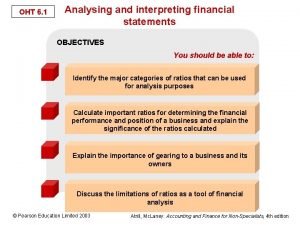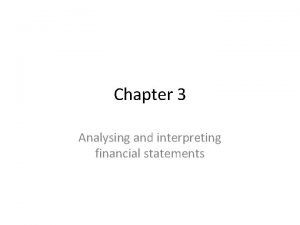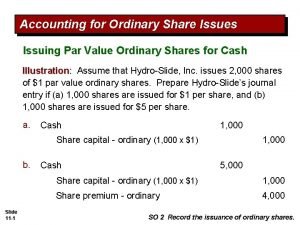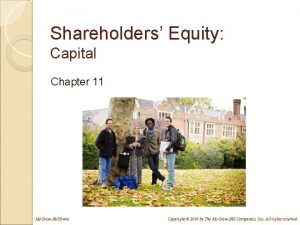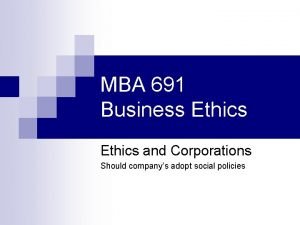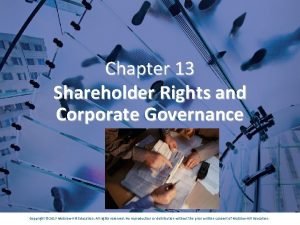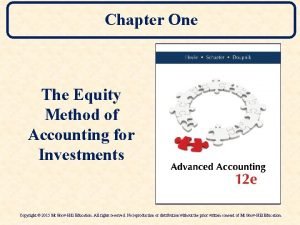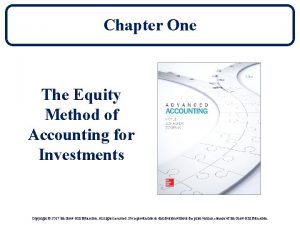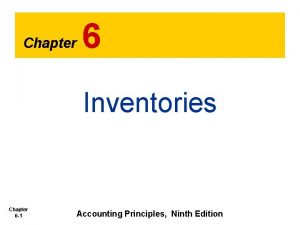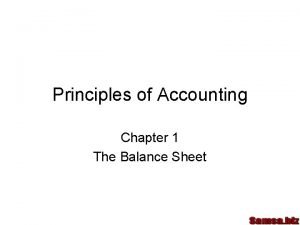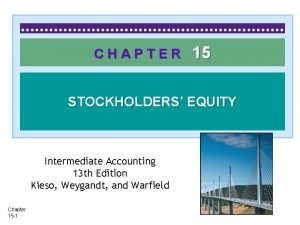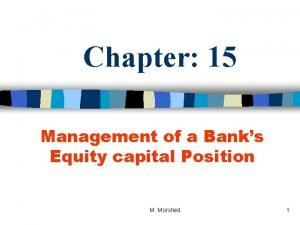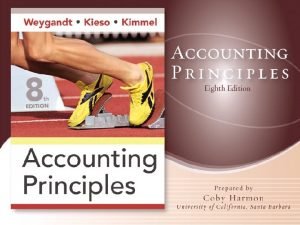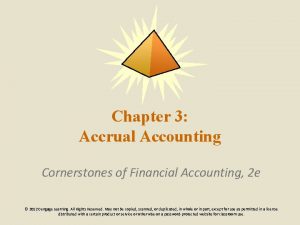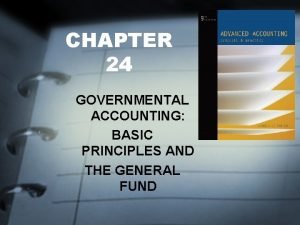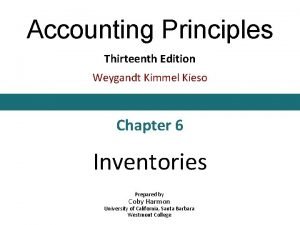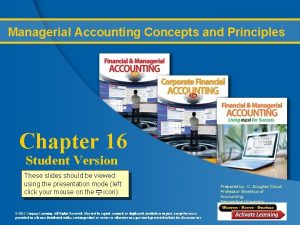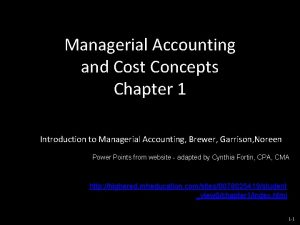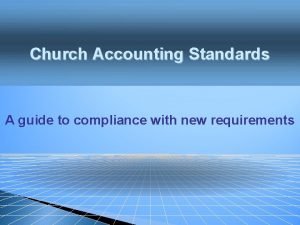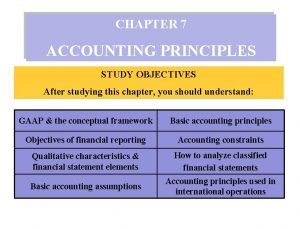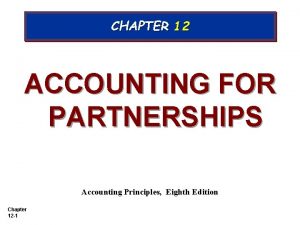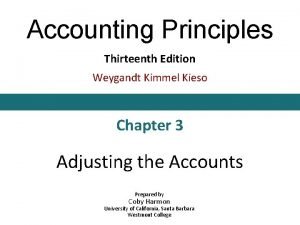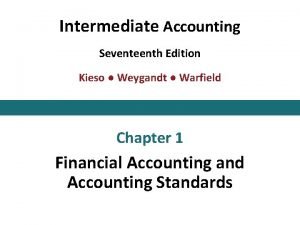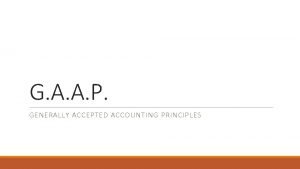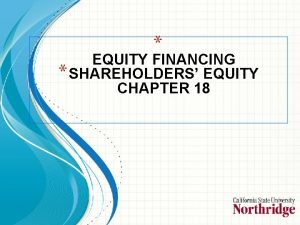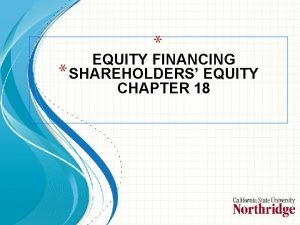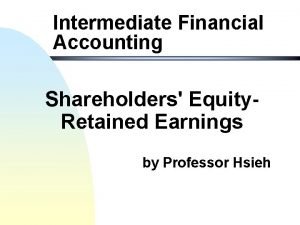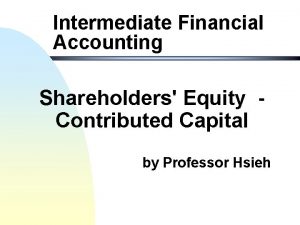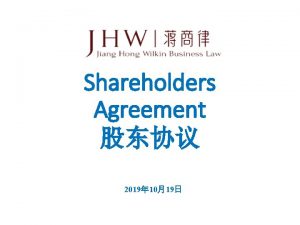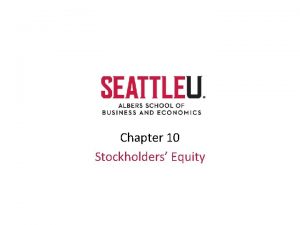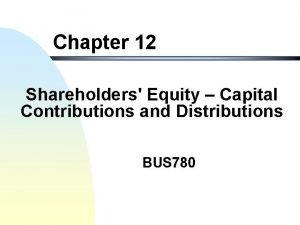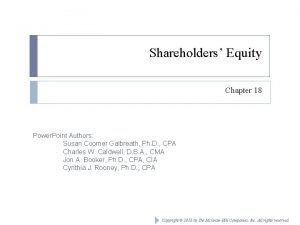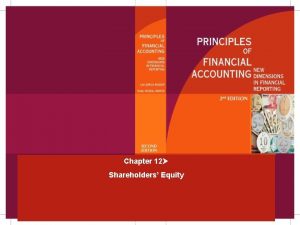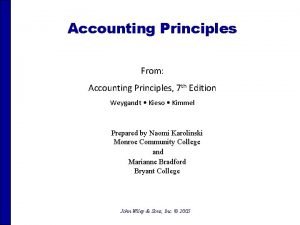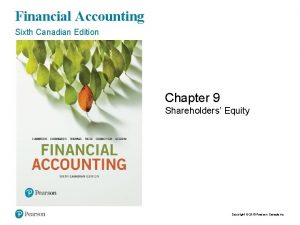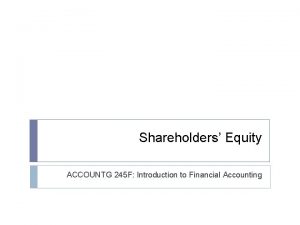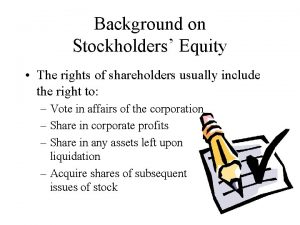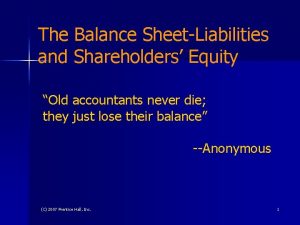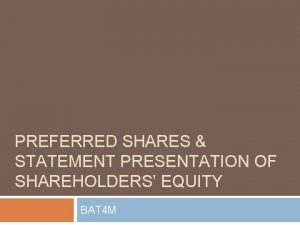CHAPTER 12 SHAREHOLDERS EQUITY Principles of Accounting with




































![Book Value Method (장부금액법) [When declared] Retained Earnings xxx (based on the par value Book Value Method (장부금액법) [When declared] Retained Earnings xxx (based on the par value](https://slidetodoc.com/presentation_image_h2/2134f241566df27834ef718fbe864280/image-37.jpg)
![Market Value Method (시가법) [When declared] Retained Earnings xxx (based on the market value Market Value Method (시가법) [When declared] Retained Earnings xxx (based on the market value](https://slidetodoc.com/presentation_image_h2/2134f241566df27834ef718fbe864280/image-38.jpg)
















- Slides: 54

CHAPTER 12 SHAREHOLDERS’ EQUITY Principles of Accounting with Key Words in Korean Soon Suk Yoon • Hyo Jin Kim Power. Point Presentation by: Soon Suk Yoon, Professor, Western Illinois University Hyo Jin Kim, Associate Professor, Jeonju University 2016

1 INTRODUCTION 13 -4

3 Forms of Business Entity • Sole proprietorship • Partnership • Corporation • What are pros & cons of each?

1 Characteristics of a Corporation A corporation is a legal entity, distinct and separate from the individuals who create and operate it. As a legal entity, a corporation may acquire, own, and dispose of property in its own name.

Advantages and Disadvantages of Corporation • - Advantages Limited legal liability Transferability of ownership Going concern Legal entity Fund-raising ability • - Disadvantages Double taxation Regulation Cost of compliance

2 TERMINOLOGY 13 -17

Terminology • • • Stockholder or shareholder (주주) Preemptive rights (주식선매권) Board of directors (이사회) Par value (액면금액) Stock exchange (주식시장) Authorized shares (수권자본) Issued shares (발행주식) Treasury shares(자기주식) Outstanding shares (유통주식) Dividends (배당금) Subscribed shares (청약주식)

Example 12 -1 Outstanding Shares Alien Company has an authorization for 100, 000 shares. During 20× 1, 80, 000 shares were issued. During the year, the company bought back 5, 000 shares. The outstanding shares at year’s end are determined as follows: Issued Shares 80, 000 Less: Treasury Shares 5, 000 Outstanding Shares 75, 000 Dividends will be paid on the outstanding shares of 75, 000.

3 TYPES OF SHARES 13 -17

Types of Shares Two types of shares : § Ordinary shares (보통주) and Preference shares (우선주). They are also called common stocks and preferred stocks, respectively. § Ordinary share represents the basic ownership right. § Preference share does not have voting rights ( 의결권) but has preference over ordinary shares in the event of liquidation (청산) and dividend (배당) distribution.

Some Added Features of Preference Shares • Cumulative preference shares (누적적우선주): If dividends are not paid in a given year, they must be paid before ordinary shareholders receive any dividends. Dividends not paid are called ‘Dividends in Arrears (연체배당금)’. • Participating preference shares (참가적우선주 ): In addition to the regular specified dividends, the preference shares will participate in the additional dividends paid.

Example 12 -2 Cumulative Preference Shares Hornet Corporation has 10, 000 shares of cumulative, nonparticipating preference share paying dividends of $2 per share. There are 35, 000 shares of ordinary share. In 20× 1 and 20× 2, no dividends were paid. In 20× 3, dividends of $82, 000 were paid. The dividend distribution in 20× 3 is: Preference Share (10, 000 shares×$2× 3 years) $60, 000 Ordinary share($82, 000-$60, 000) 22, 000 Total Dividend $82, 000

4 Shareholders’ equity 13 -17

2 Shareholders’ Equity The owner’s equity in a corporation is called shareholders’ equity (주주지분), stockholders’ equity, net assets (순자산) or capital (자본). Shareholders’ equity consists of share capital ( 자본금), share premium (자본잉여금), accumulated other comprehensive income (기 타포괄손익누계액), capital adjustments (자본 조정) and retained earnings (이익잉여금).

2 The two main sources of capital are: 1. Capital contributed to the corporation by the stockholders, called paid-in capital or contributed capital (납입자본). 2. Net income retained in the business, called retained earnings (이익잉여금, 유보이익).

5 Issuance of shares (주식의 발행) 13 -22

Issue of Shares § Issue at par value (액면발행): Issue price = Par value § Issue at a premium (할증발행): Issue price > Par value Share premium (주식발행초과금) § Issue at a discount (할인발행) : Issue price < Par value Share discount (주식할인발행차금)

Example 12 -3 Issuance at Par Value Wasp Corporation issued at par 1, 000 shares of $10 par value ordinary share. The journal entry is: Cash 10, 000 Ordinary Shares 10, 000

Example 12 -4 Share Premium and Discount (1) Grasshopper Corporation issued 50, 000 shares of $10 par value ordinary shares for $15 a share. The journal entry is: Cash 750, 000 Ordinary Shares 500, 000 Share Premium - Ordinary Shares 250, 000 (2) Grasshopper Corporation issued 10, 000 shares of $20 par value preference shares for $19 a share. The journal entry is: Cash 190, 000 Share Discount - Preference Shares 10, 000 Preference Shares 200, 000

Presentation of Shareholders’ Equity Section Shareholders' equity section has many sub-components. They are share capital (자본금), share premium (주식발 행초과금), retained earnings (이익잉여금), accumulated other comprehensive income (기타포괄손익누계액) and capital adjustments (자본조정). Companies usually have the first three items at least. Some companies may have the last two items also. The shareholders' equity section should clearly show them separately.

Example 12 -5 Shareholders’ Equity Using the information in Example 12 -4, assuming Grasshopper Corporation’s retained earnings balance is $40, 000, we can show the shareholders’ equity section as follows: Statement of Financial Position (Partial) Shareholders’ Equity Share Capital Preference Shares, $20 par value, issued and outstanding 10, 000 shares Ordinary Shares, $10 par value, issued and outstanding 50, 000 shares Share Premium Share Discount on Preference Shares Share Premium on Ordinary Shares Retained Earnings Total Shareholders’ Equity $200, 000 500, 000 ($10, 000) 250, 000 $700, 000 240, 000 $980, 000

Issue of Shares for Non-cash Assets If shares are issued for other than cash, the asset received is recorded at its fair market value (공정시장가치).

Example 12 -6 Exchange of Shares with Assets Baboon Corporation issued 1, 000 shares of $5 par value ordinary share in exchange for land valued at $5, 500. The journal entry is: Land 5, 500 Ordinary Shares 5, 000 Share Premium - Ordinary Shares 500

6 Treasury shares 13 -62

Treasury Shares Treasury stock (자기주식) represents issued shares that have been reacquired by the company. When treasury shares are resold, the difference between the selling price and the cost is reflected in an account called Paid-In Capital from Treasury Shares (자기주 식자본잉여금, 자기주식처분이익).

Example 12 -7 Treasury Shares Dugong Company’s shareholders’ equity section of its balance sheet as of December 31, 20× 1 appears below. Statement of Financial Position (Partial) December 31, 20× 1 Shareholders’ Equity Share Capital Ordinary Shares, $10 par value, authorized 40, 000 shares; issued and outstanding 20, 000 shares Share Premium on Ordinary Shares Retained Earnings Total Shareholders’ Equity $200, 000 15, 000 20, 000 $235, 000

Example 12 -7 Treasury Shares - Continued The company had the following transactions during 20× 2: April 7-Purchased 1, 000 shares of outstanding ordinary shares at $18 per share Aug. 16-Sold 400 shares of treasury shares at $20 per share Dec. 6-Sold 250 shares of treasury shares at $16 per share The appropriate journal entries for the above transactions are: April 7 Treasury Shares 18, 000 Cash 18, 000 Aug. 16 Cash 8, 000 Treasury Shares 7, 200* Share Premium from Treasury Shares 800 Dec. 6 Cash 4, 000 Share Premium from Treasury Shares 500 Treasury Shares 4, 500** * 400 shares×$18=$7, 200 ** 250 shares×$18=$4, 500

Example 12 -7 Treasury Shares - Continued Assume the net income for the year was $3, 000. The shareholders’ equity section of the balance sheet at December 31, 20× 2 follows: Statement of Financial Position (Partial) December 31, 20× 2 Shareholders’ Equity Share Capital Ordinary Shares, $10 par value, authorized 40, 000 shares; issued 20, 000 shares Share Premium on Ordinary Shares Premium from Treasury Shares Retained Earnings Subtotal Less: Treasury Shares (350 shares at cost) Total Shareholders’ Equity * $800-$500=$300 ** $18, 000-$7, 200-$4, 500=$6, 300 $200, 000 $15, 000 300* 15, 300 23, 000 $238, 300 6, 300** $232, 000

7 Dividends 13 -43

Dividends § Dividends are paid out of retained earnings. § Two forms of dividends: - Cash dividends (현금배당) - Share dividends (주식배당) § 3 key dates Date of Declaration (배당선언일) Retained Earnings xxx Dividends Payable xxx Date of Record (배당기준일) No entry Date of Payment (배당지급일) Dividends Payable Cash xxx

4 Date of Declaration (배당선언일) The date of declaration is the date the shareholders’ meeting (주주총회) or the board of directors (이사회) formally authorized the payment of the dividend. On this date, the corporation incurs the liability to pay the amount of the dividend.

4 Date of Record (배당기준일) The date of record is the date the corporation used to determine which shareholders will receive the dividend.

4 Date of Payment (배당지급일) The date of payment is the date the corporation will pay the dividends to the shareholders who owned the share on the date of record.

4 Cash Dividends (현금배당) A cash distribution of earnings by a corporation to its shareholders is called a cash dividend. There are usually three conditions that a corporation must meet to pay a cash dividend. 1. Sufficient retained earnings 2. Sufficient cash 3. Formal action by the shareholders’ meeting (주 주총회) or the board of directors (이사회)

Example 12 -8 Cash Dividends-Ordinary Shares On November 15, 20× 1, a cash dividend of $1. 50 per share was declared on 10, 000 shares of $10 par value ordinary shares. The record date is December 20, 20× 1. Payment is to be made on January 15, 20× 2. The journal entries are: Nov. 15, 20× 1 Retained Earnings 15, 000 * Dividends Payable 15, 000 Dec. 20, 20× 1 No Entry Jan. 15, 20× 2 Dividends Payable 15, 000 Cash 15, 000 * 10, 000 shares×$1. 50=$15, 000 Note that dividends payable is a current liability account.

4 Stock Dividends (주식배당) § A distribution of dividends to shareholders in the form of the firm’s own shares is called a share dividend. § A share dividend can be accounted for using the market value method (시가법) or the book value method (장부금액법). § The market value method is believed to be appropriate for share dividends of less than 2025 percent of the outstanding shares. § The book value method is appropriate for share dividends of more than 20 -25 percent of the outstanding shares.
![Book Value Method 장부금액법 When declared Retained Earnings xxx based on the par value Book Value Method (장부금액법) [When declared] Retained Earnings xxx (based on the par value](https://slidetodoc.com/presentation_image_h2/2134f241566df27834ef718fbe864280/image-37.jpg)
Book Value Method (장부금액법) [When declared] Retained Earnings xxx (based on the par value of the shares) Share Dividend Distributable xxx (based on the par value of the shares) [When distributed] Share Dividend Distributable Ordinary Shares xxx
![Market Value Method 시가법 When declared Retained Earnings xxx based on the market value Market Value Method (시가법) [When declared] Retained Earnings xxx (based on the market value](https://slidetodoc.com/presentation_image_h2/2134f241566df27834ef718fbe864280/image-38.jpg)
Market Value Method (시가법) [When declared] Retained Earnings xxx (based on the market value of the shares) Share Dividend Distributable xxx (based on the par value of the shares) Premium on Ordinary Shares [When distributed] Share Dividend Distributable Ordinary Shares xxx xxx

Example 12 -9 Share Dividends Termite Corporation has 40, 000 shares of $10 par value ordinary shares outstanding. On December 1, 20× 1, it declared a 5 percent share dividend to the shareholders of record on December 31, 20× 1. On December 7, the market price of the share was $25 per share. The issuance date is February 6, 20× 2. Appropriate journal entries follow: Dec. 1, 20× 1 Retained Earnings 50, 000 * Share Dividends Distributable 20, 000** Premium on Ordinary Shares 30, 000 Dec. 31, 20× 1 No Entry Feb. 6, 20× 2 Share Dividends Distributable 20, 000 Ordinary Shares 20, 000 * 40, 000 shares× 5%×$25=$50, 000 ** 2, 000 shares×$10=$20, 000

Example 12 -10 Dividends for Preference Shares and Ordinary Shares Condor Corporation has two classes of shares: 5%, cumulative, $100 par value preference shares and $10 par value ordinary shares. There have been 500 shares of preference share and 1, 000 shares of ordinary share issued and outstanding since the beginning of 20× 1. There were no additional share transactions during 20× 1 and 20× 2. Condor did not pay dividends to shareholders in 20× 1. On December 31, 20× 2, Condor declared dividends in the amount of $8, 000. Make the appropriate journal entry on the date of declaration assuming that Condor has sufficient retained earnings to pay dividends. December 31, 20× 2 Retained Earnings 8, 000 Dividends Payable - Preference Shares Dividends Payable - Ordinary Shares * 500 shares× 5%×$100× 2 years=$5, 000 ** $8, 000-$5, 000=$3, 000 5, 000* 3, 000**

8 Share splits 13 -84

7 Share Split (주식분할) A share split is a process by which a corporation reduces the par or stated value of the ordinary share and issues a proportionate number of additional shares.

Example 12 -11 Share Split Orange Corporation has 1, 000 shares of $20 par value ordinary shares. The total par value is thus $20, 000. A two-for-one share split is issued. There will be now 2, 000 shares with $10 par value. The total par value remains at $20, 000. Theoretically, the market price per share should also drop to one -half of what it was before the split.

9 RETAINED EARNINGS 13 -84

6 Retained Earnings Retained earnings (이익잉여금, 유보이익) is the accumulated earnings of the business that have not been distributed to shareholders. A profitable business will have a credit balance. However, if accumulated losses exceed accumulated earnings, the account will have a debit balance(deficit). Retained earnings is shown in the shareholders’ equity section.

6 Retained Earnings § Retained earnings may be either unappropriated (free for dividend distribution) or appropriated (reserved and unavailable for dividend distribution). § When an appropriation (적립, 처분) is made, unappropriated retained earnings (미처분이익잉여 금) is reduced and the specific appropriated retained earnings (처분이익잉여금) account is established. § The total retained earnings consist of the unappropriated retained earnings and the appropriated retained earnings accounts.

6 Retained Earnings When an appropriation is established, the following entry is made: Retained Earnings xxx Appropriated Retained Earnings xxx When the appropriation is no longer needed, the above entry is reversed: Appropriated Retained Earnings xxx

Example 12 -12 Appropriation of Retained Earnings Capybara Corporation has a balance in retained earnings of $80, 000. The company decides to establish a reserve for plant expansion of $15, 000. The entry is: Retained Earnings 15, 000 Appropriation for Plant Expansion 15, 000 The company also establishes a reserve for the acquisition of $5, 000 of treasury shares. The entry for the appropriation is: Retained Earnings 5, 000 Appropriation for Treasury Shares 5, 000 Under the stockholders’ equity section, retained earnings would be broken down as follows: Statement of Financial Position(Partial) Unappropriated Retained Earnings Appropriated Retained Earnings: For Plant Expansion For Treasury Shares Total Retained Earnings * 80, 000-$15, 000-$5, 000=$60, 000* $15, 000 20, 000 $80, 000

Accounting Terminologies in Chapter 12 accumulated other comprehensive income appropriated retained earnings appropriation articles of incorporation authorized shares board of directors book value method capital adjustments cash dividends charter common stock cumulative preference share 기타포괄손익누계액 처분이익잉여금 적립(처분) 정관 수권자본 이사회 장부금액법 자본조정 현금배당 정관 보통주 누적적우선주

Accounting Terminologies in Chapter 12 date of record declaration date dividends in arrears double taxation 배당기준일 선언일 배당금 연체배당금 이중과세 Financial Supervisory Service 금융감독원 fund-raising ability going concern issuance of shares issued shares legal entity limited liability 자금조달능력 계속기업 주식의 발행 발행주식 법인 유한책임

Accounting Terminologies in Chapter 12 liquidation market value method noncumulative preference share nonparticipating officers ordinary share outstanding shares paid-in capital par value participating preference share payment date preemptive rights 청산 시가법 비누적적우선주 비참가적 임원 보통주 유통주식 납입자본 액면가액 참가적우선주 배당지급일 주식선매권

Accounting Terminologies in Chapter 12 preference share preferred stock premium from treasury shares retained earnings share capital share certificate share discount share dividends distributable share premium share split 우선주 자기주식자본잉여금 이익잉여금 주식 자본금 주권 주식할인발행차금 주식배당 미배당주식 주식발행초과금 주식분할

Accounting Terminologies in Chapter 12 shareholders' equity shareholders' meeting stakeholders stock exchange stockholder subscribed shares transfer of ownership treasury shares 주주 주주지분 주주총회 이해관계자 증권시장 주주 청약주식 소유권이전 자기주식 unappropriated retained earnings 미처분이익잉여금 unissued shares voting right 미발행주식 의결권

 Shareholders equity and shareholders funds
Shareholders equity and shareholders funds Oht share price
Oht share price Rosf ratio
Rosf ratio Return on ordinary shareholders equity formula
Return on ordinary shareholders equity formula Chapter 11 shareholders rights
Chapter 11 shareholders rights Intermediate accounting chapter 15 equity bahasa indonesia
Intermediate accounting chapter 15 equity bahasa indonesia Salaam bank somaliland
Salaam bank somaliland Stockholders vs shareholders
Stockholders vs shareholders Types of shareholders
Types of shareholders Types of shareholders
Types of shareholders Avocet shareholders forum
Avocet shareholders forum West wits mining top 20 shareholders
West wits mining top 20 shareholders Equity journal entries examples
Equity journal entries examples Chapter 2 financial accounting answers
Chapter 2 financial accounting answers Equity accounting vs proportionate consolidation
Equity accounting vs proportionate consolidation Equity method accounting journal entries
Equity method accounting journal entries Intermediate accounting chapter 1
Intermediate accounting chapter 1 Equity principles
Equity principles Chapter 6 inventories
Chapter 6 inventories Principles of accounting chapter 1
Principles of accounting chapter 1 Grading for equity chapter 7
Grading for equity chapter 7 Apes chapter 20 sustainability economics and equity
Apes chapter 20 sustainability economics and equity Chapter 15 stockholders equity
Chapter 15 stockholders equity Chapter 15 debt and equity capital
Chapter 15 debt and equity capital Introduction of computerized accounting
Introduction of computerized accounting Going concern concept
Going concern concept Accounting responsibility
Accounting responsibility Pharmacy accounting principles
Pharmacy accounting principles Accounting chapter 6
Accounting chapter 6 Accrual accounting principles
Accrual accounting principles Accounting principles second canadian edition
Accounting principles second canadian edition Accounting principles second canadian edition
Accounting principles second canadian edition Accounting principles second canadian edition
Accounting principles second canadian edition Accounting principles and policies
Accounting principles and policies Accrual accounting principles
Accrual accounting principles Accounting assumptions
Accounting assumptions Development of accounting principles
Development of accounting principles Generally accepted accounting principles (gaap) adalah
Generally accepted accounting principles (gaap) adalah Difference between manual and computerized accounting
Difference between manual and computerized accounting 6 principles of accounting
6 principles of accounting Government accounting basics
Government accounting basics Accounting principles 13th edition
Accounting principles 13th edition Accounting principles second canadian edition
Accounting principles second canadian edition Materiality constraint
Materiality constraint What are constraints in accounting
What are constraints in accounting Accounting principles and concepts
Accounting principles and concepts Managerial accounting and cost concepts
Managerial accounting and cost concepts Accounting equation
Accounting equation Introduction to accounting
Introduction to accounting Church accounting rules
Church accounting rules 7 accounting principles
7 accounting principles 12 accounting principles
12 accounting principles Accounting principles 13th edition
Accounting principles 13th edition Intermediate accounting
Intermediate accounting Time period principle example
Time period principle example

